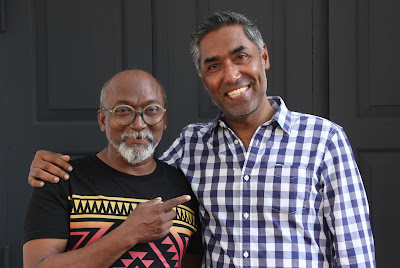COLUMN:
LOCATION DIARY
Actor
Vineeth talks about his experiences in the films, 'Nakhakshathangal',
'Kadhal Desam' and 'Sakthi'
Photos: Vineeth; Vineeth and Monisha Unni in the film, 'Nakhakshathangal',
By
Shevlin Sebastian
In
the film, 'Nakhakshathangal' (1986), Vineeth, who plays a 16-year-old
boy Ramu meets an equally young Gowri (played by the late Monisha
Unni) at the home of a lawyer.
Then
she takes him to the dining room to have a cup of tea. The chief cook
is played by Kuthiravattam Pappu. “As soon as he comes in, he
speaks in a mocking voice and tells her that her visitors are
supposed to sit in the kitchen, and not in the dining room,” says
Vineeth. “But the way he spoke, in his nasal voice and quaint
mannerisms, I found it funny.”
Vineeth
would start laughing and, invariably, Monisha would also end up
joining him. Every time, the scene had to be shot, both would laugh.
“[Director] Hariharan Sir showed a lot of patience,” says
Vineeth. “But soon Pappu began complaining, because it was
affecting his timing and spontaneity.”
Finally
Hariharan lost his cool. Abruptly, he got up and walked out of the
house in Shoranur. The crew fell silent. “Both Monisha and I were
in shock,” says Vineeth.
The
assistant director remonstrated with them. “What is happening to
you two?” he said.
After
an hour, Hariharan returned. “This time, somehow, we managed to
control our laughter, and the scene was shot, to our relief,” says
Vineeth. “This was an experience that I will never forget.”
Another
experience that Vineeth has not forgotten took place on the sets of
the Tamil film, 'Kadhal Desam'. The shooting of the AR Rahman hit
song, ‘Mustafa, Mustafa’ was taking place at Presidency College,
in Chennai, which was adjacent to a slum. There were several dancers
as well as junior artistes.
However,
one evening, some young men, armed with knives, came barging into the
set, led by a ten-year-old. “They showered abuses on us,” says
Vineeth. “One of them shouted, ‘Where the hell is the girl? Who
does she think she is?’”
Apparently,
the boy had been going around selling peanuts. According to the boy's
version, one of the dancers said, “You scoundrel, get out.”
Anyway, in the chaos, the girl was spirited away in a car. Finally,
the crew members intervened, apologies were given, and the mollified
youths left.
Vineeth
had a completely different experience during the shoot of the Tamil
film, 'Sakthi' (1997). For a particular sequence, at a stream in
Pollachi, Vineeth was supposed to intervene in a fight between an
elephant and a crocodile.
“Kanal
Kannan, a top fight master, told me not to worry,” says Vineeth.
Kannan's
asssistant Peter Hein [of 'Pullimurugan' fame] showed me how to pick
up the crocodile and come out of the water.”
To
do that, an iron wire was tied around its stomach. The mouth, with
the protruding teeth, was also closed up with a wire. The crocodile
was quiet. He was floating in the water.
Vineeth
went and touched it, in order to get over his fear. “It did not
react at all,” says Vineeth. “But his eyes kept winking.”
The
shoot began. Vineeth ran into the water, called out the name of God,
picked up the crocodile, ran back to the bank and flung it down.
“There were five takes,” says Vineeth. “Throughout, the
crocodile remained quiet.” The shoot was completed on time.
Thereafter,
the crew took a break. Following that, the crocodile became extremely
violent. “Nobody could go near it,” says Vineeth. “Thank God,
the shoot was over. Otherwise, it would have been very difficult.”
(The
New Indian Express, Kochi, Thiruvananthapuram and Kozhikode)

















